 Ivana Lotoshynski, CFP®
Ivana Lotoshynski, CFP®
People Wealth Matters
Financial Advisor
https://peoplewealthmatters.com
ilotoshynski@peoplewealthmatters.com
Monthly Market Insights | September 2024
U.S. Markets
Stocks notched modest gains in August, helping investors forget a volatile month of trading, punctuated by upbeat comments by Fed officials about interest rates.
The Dow Jones Industrial Average rose 1.76 percent, while the S&P 500 Index tacked on 2.28 percent. The Nasdaq Composite lagged a bit, advancing 0.65 percent.1
“I don’t know that there are any shortcuts to doing a good job.”
Sandra Day O’Connor, the first woman to serve as a U.S. Supreme Court justice
An Unsettling Jobs Report
August began with a disappointing employment report showing July job growth slowed much more than expected, and unemployment moved to 4.3 percent—the highest rate since October 2021. On the same day, Japan’s Nikkei dropped quickly as investors cashed out of a popular trading strategy called a “carry trade,” which briefly pressured global financial markets.2,3
Progress on Inflation
Almost as fast as markets fell, they bounced back, however. News that initial jobless claims fell more than expected—a positive sign for the labor markets—quieted some of the festering recession talk. Also, there was growing speculation that the July jobs report was more of an outlier that was perhaps influenced more than expected by Hurricane Beryl, which arrived in the U.S. in late June.4
Fresh economic data also bolstered investor confidence. The Producer Price Index and the Consumer Price Index rose less than expected in July, reinforcing the “cooling inflation” narrative. The July retail sales report was stronger than expected, which helped boost sentiment.5,6,7
Fed Officials Taking a Stand?
Despite mixed signals earlier this year, Fed officials now appear coordinated with their messaging about interest rates.
Constructive comments in the July Federal Open Market Committee meeting minutes showed policymakers were open to cutting short-term interest rates. A short time later, Fed Chair Jerome Powell, in his Jackson Hole symposium speech, indicated the time had come to adjust policy. And throughout the month, other Fed officials made speeches that suggested a rate change may be sooner rather than later.8
Sector Scorecard
Nine out of the 11 S&P 500 sectors finished the month higher. Consumer Staples (+5.99 percent) and Real Estate (+5.73 percent) led, with Financials (+4.57 percent), Utilities (+4.81 percent), and Health Care (+5.06 percent) not far behind.9
Industrials (+2.82 percent), Communication Services (+1.78 percent), and Materials (+2.32 percent) also posted solid gains. Technology lagged, climbing 0.70 percent. Energy (-2.07 percent) and Consumer Discretionary (-0.20 percent) fell for the month.9
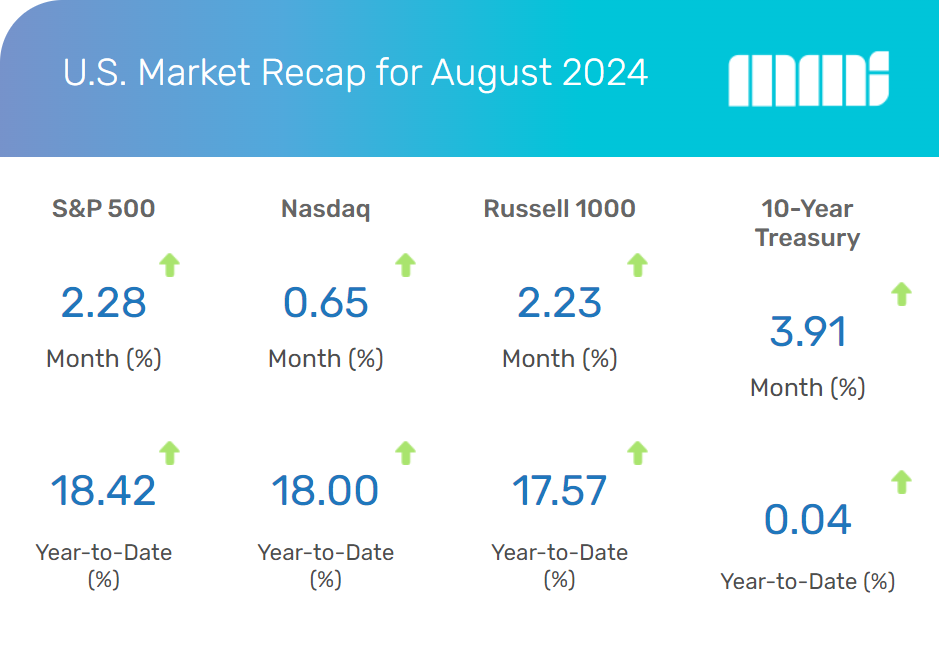
Yahoo Finance, August 31, 2024. The market indexes discussed are unmanaged and generally considered representative of their respective markets. Individuals cannot directly invest in unmanaged indexes. Past performance does not guarantee future results. U.S. Treasury Notes are guaranteed by the federal government as to the timely payment of principal and interest. However, if you sell a Treasury Note prior to maturity, it may be worth more or less than the original price paid.
What Investors May Be Talking About in September
Expect attention to shift to the Fed’s next two-day meeting, which is scheduled to start on September 17.
Investors anticipate the Fed will follow up on its dovish talk in August with a rate adjustment at the conclusion of the Federal Open Market Committee (FOMC) meeting.10
Some still believe that the Fed may be reluctant to make any changes this close to the election, but most market observers seemed to dismiss that idea.10
“The time has come for policy to adjust,” Powell told a gathering of global central bankers in August at the Fed’s annual Jackson Hole, Wyoming, conference. “The direction of travel is clear, and the timing and pace of rate cuts will depend on incoming data, the evolving outlook, and the balance of risks.”
World Markets
The MSCI-EAFE Index gained 3.02 percent in August as markets rallied globally and central banks lowered rates.11
European stocks rallied, with Spain (+3.04 percent), Italy (+4.61 percent), Germany (+2.15 percent), France (+1.32 percent) and the United Kingdom (+1.13 percent) making solid advances.12
Pacific Rim markets were mixed. While China’s Hang Seng index picked up 3.72 percent, Japan’s Nikkei lost 1.16 percent. Japan’s Nikkei had an exceptionally volatile month as investors grappled with “carry trade” transactions, which is when speculators borrow money in a country with low interest rates and invest in currencies with a higher interest rate.13
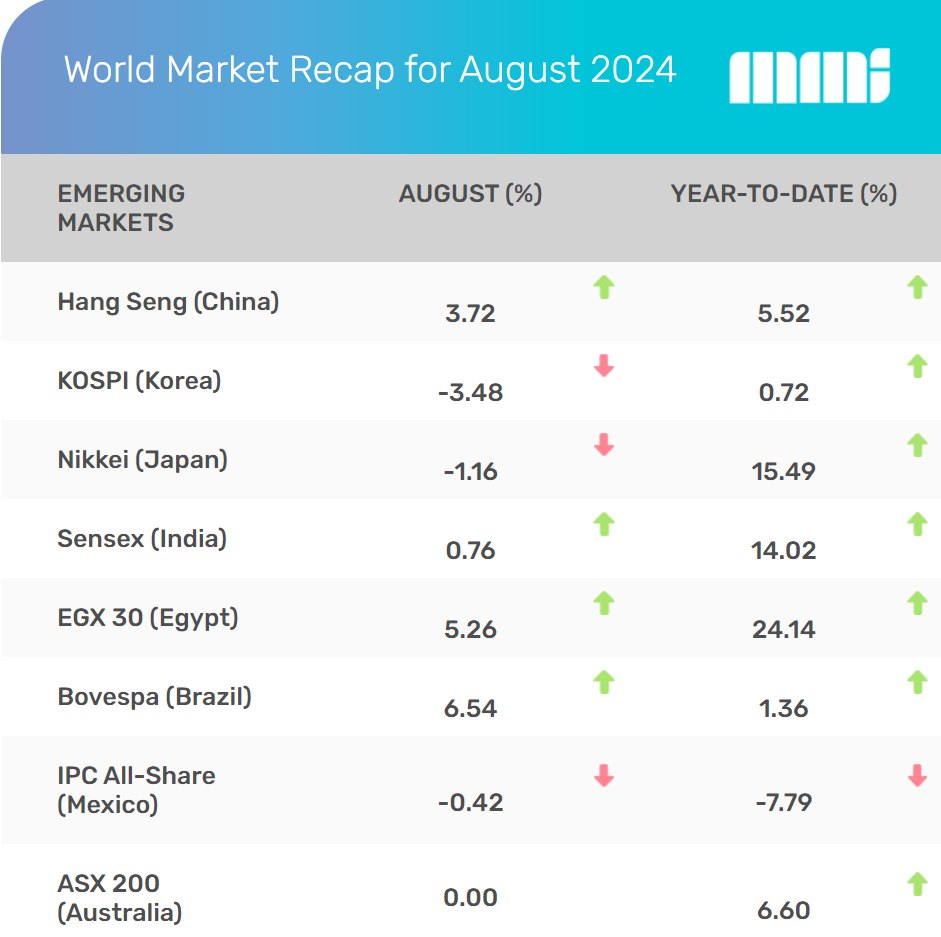
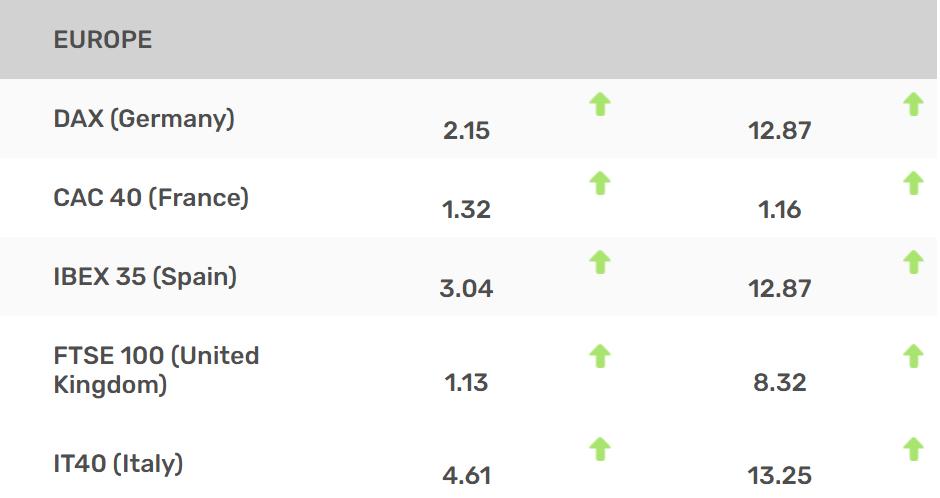
Yahoo Finance, August 31, 2024. The market indexes discussed are unmanaged and generally considered representative of their respective markets. Individuals cannot directly invest in unmanaged indexes. Past performance does not guarantee future results. International investments carry additional risks, which include differences in financial reporting standards, currency exchange rates, political risks unique to a specific country, foreign taxes and regulations, and the potential for illiquid markets. These factors may result in greater share price volatility.
Indicators
Gross Domestic Product (GDP)
The economy grew 3.0 percent on an annualized basis in Q2, revised upward from the initial 2.8 percent estimate. GDP was more than doubled the first quarter’s 1.4 percent expansion.14
Employment
Employers added 114,000 jobs in July, fewer than economists expected. The unemployment rate moved higher to 4.3 percent, its highest level since October 2021. Average hourly earnings increased 3.6 percent year-over-year in July—the smallest wage gain since May 2021.15
Retail Sales
Spending rose in July by 1.0 percent month-over-month, led by an increase in auto sales. July’s gain exceeded the 0.3 percent economists expected.16
Industrial Production
Industrial output fell 0.6 percent in July, more than expected. It was the largest since January 2024, half of which came from the impacts of Hurricane Beryl on energy production.17
Housing
Housing starts fell 6.8 percent in July, impacted by high mortgage rates. The July number came in short of the number economists expected. Year over year, total starts fell 16 percent.18
Sales of previously owned homes rose 1.3 percent, slightly more than economists expected and a reversal after four consecutive months of declines. Improving inventory and falling mortgage rates contributed. The median for existing home sales price was up 4.2 percent year-over-year, to $422,600.19
New home sales rose 10.6 percent, with all four regions of the country seeing increases. The median new home sales price was $429,800.20
Consumer Price Index (CPI)
Consumer prices rose 0.2 percent in July on a month-over-month basis. Year-over-year prices increased 2.9 percent in July. It marked the first time the CPI fell below 3 percent since early 2021. Core inflation (CPI minus volatile food and energy prices) rose 3.2 percent in July, also a three-year low.21
Durable Goods Orders
New orders of manufactured goods designed to last three years or longer increased 9.9 percent in July, compared with June’s 6.9 percent decrease. Transportation drove the surge, without which new orders would have decreased by 0.2 percent.22
The Fed
While there was no formal policy meeting last month, Chair Powell’s speech at the Fed’s annual symposium in August provided some of the strongest hints yet on interest rates, saying, “The time has come for policy to adjust.”
Investors responded favorably, but many are still wondering about the Fed’s approach since Powell added that “the timing and pace of rate cuts will depend on incoming data, the evolving outlook, and the balance of risks.”23
The next scheduled two-day Fed meeting starts on September 17. It’s been 4.5 years—at the start of the pandemic—since the Fed last cut interest rates.24
By the Numbers: The Cost Of College
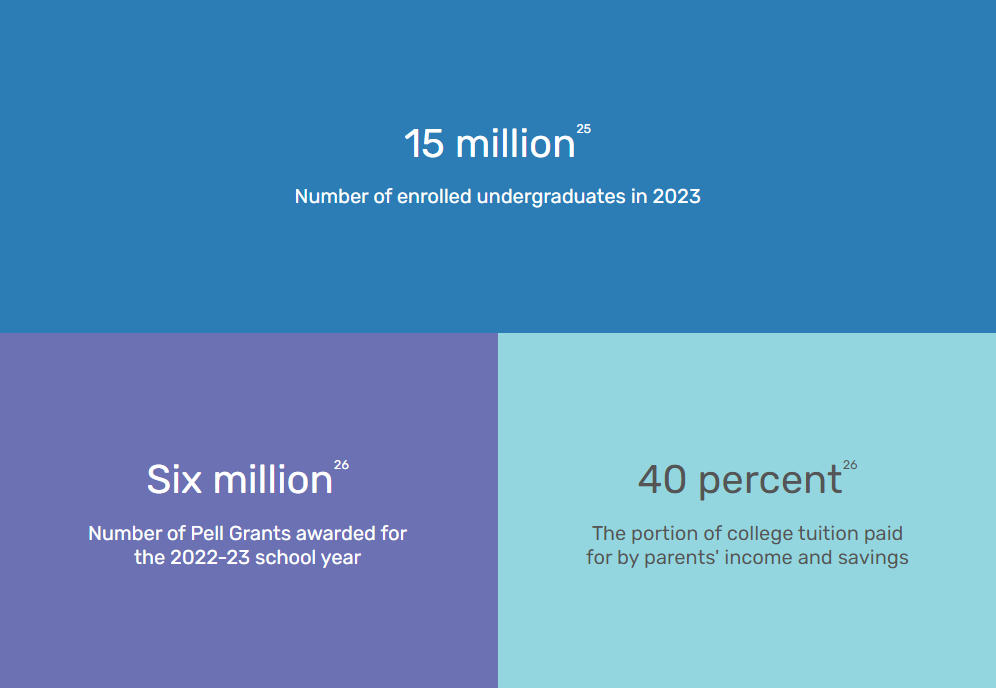
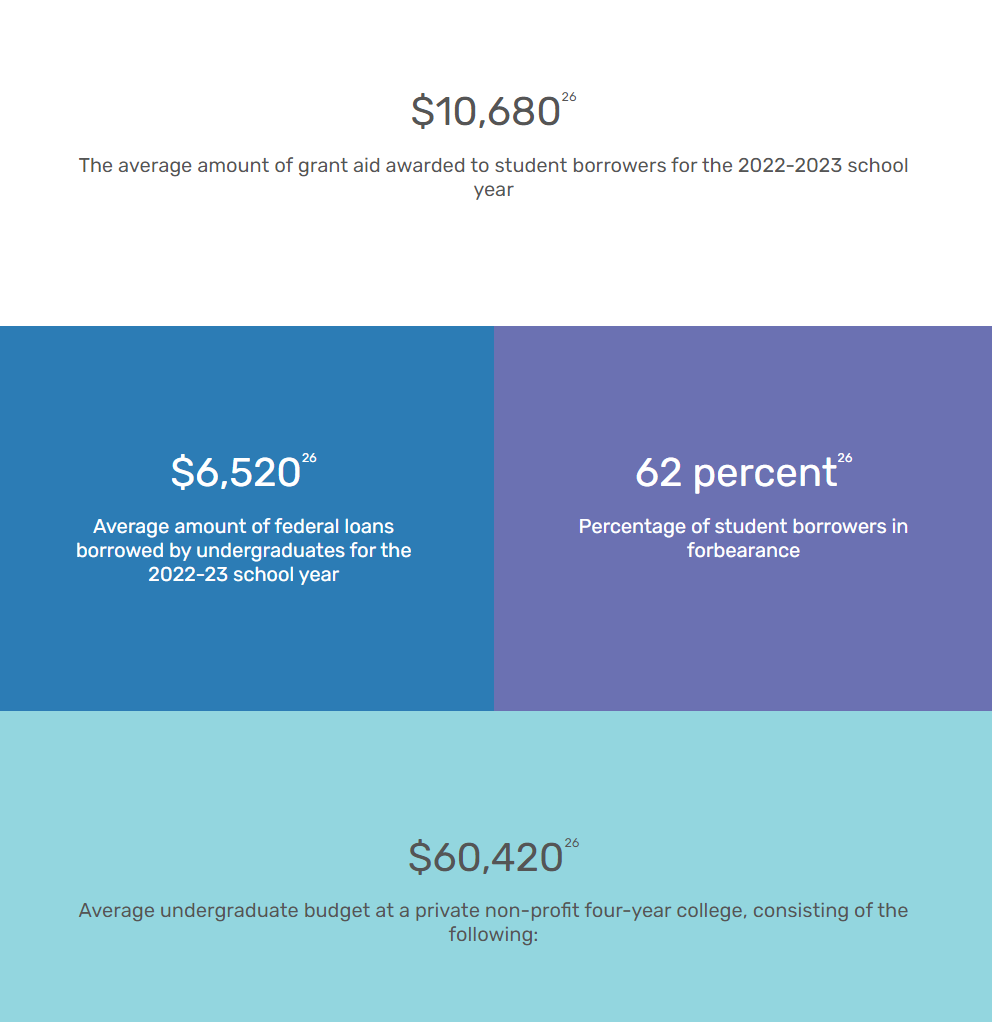
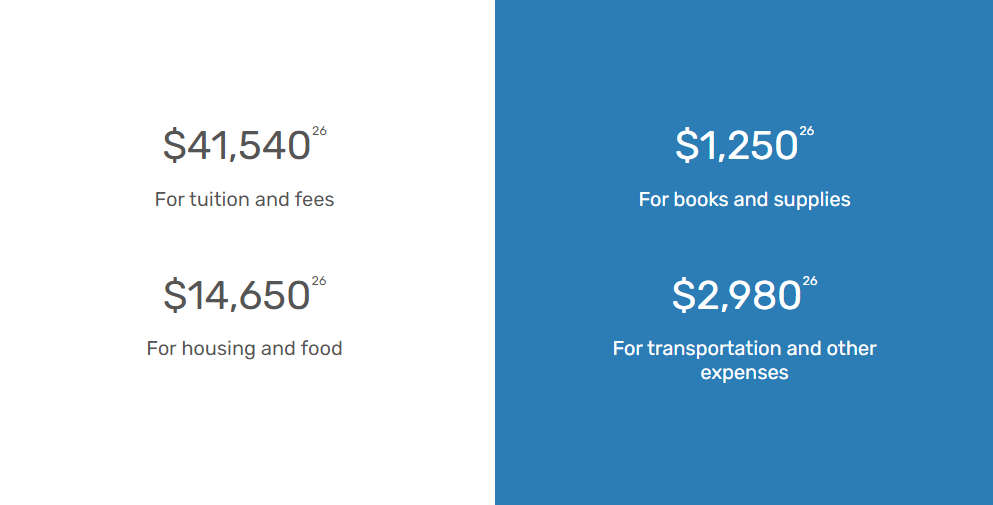
The content is developed from sources believed to be providing accurate information. The information in this material is not intended as tax or legal advice. Please consult legal or tax professionals for specific information regarding your individual situation. This material was developed and produced by FMG Suite to provide information on a topic that may be of interest. FMG Suite, LLC, is not affiliated with the named representative, broker-dealer, or state- or SEC-registered investment advisory firm. The opinions expressed and material provided are for general information and should not be considered a solicitation for the purchase or sale of any security.
Investing involves risks, and investment decisions should be based on your own goals, time horizon and tolerance for risk. The return and principal value of investments will fluctuate as market conditions change. When sold, investments may be worth more or less than their original cost.
Any companies mentioned are for illustrative purposes only. It should not be considered a solicitation for the purchase or sale of the securities. Any investment should be consistent with your objectives, timeframe, and risk tolerance.
The forecasts or forward-looking statements are based on assumptions, subject to revision without notice, and may not materialize.
The market indexes discussed are unmanaged and generally considered representative of their respective markets. Individuals cannot directly invest in unmanaged indexes. Past performance does not guarantee future results.
The Dow Jones Industrial Average is an unmanaged index that is generally considered representative of large-capitalization companies on the U.S. stock market. The S&P 500 Composite Index is an unmanaged group of securities considered to be representative of the stock market in general. The Nasdaq Composite is an index of the common stocks and similar securities listed on the Nasdaq stock market and considered a broad indicator of the performance of stocks of technology and growth companies. The Russell 1000 Index is an index that measures the performance of the highest-ranking 1,000 stocks in the Russell 3000 Index, which is comprised of 3,000 of the largest U.S. stocks. The MSCI EAFE Index was created by Morgan Stanley Capital International (MSCI) and serves as a benchmark for the performance in major international equity markets, as represented by 21 major MSCI indexes from Europe, Australia, and Southeast Asia. Index performance is not indicative of the past performance of a particular investment. Past performance does not guarantee future results. Individuals cannot invest directly in an index. The return and principal value of stock prices will fluctuate as market conditions change. And shares, when sold, may be worth more or less than their original cost.
International investments carry additional risks, which include differences in financial reporting standards, currency exchange rates, political risks unique to a specific country, foreign taxes and regulations, and the potential for illiquid markets. These factors may result in greater share price volatility.
The Hang Seng Index is a benchmark index for the blue-chip stocks traded on the Hong Kong Stock Exchange. The KOSPI is an index of all stocks traded on the Korean Stock Exchange. The Nikkei 225 is a stock market index for the Tokyo Stock Exchange. The SENSEX is a stock market index of 30 companies listed on the Bombay Stock Exchange. The Jakarta Composite Index is an index of all stocks that are traded on the Indonesia Stock Exchange. The Bovespa Index tracks 50 stocks traded on the Sao Paulo Stock, Mercantile, & Futures Exchange. The IPC Index measures the companies listed on the Mexican Stock Exchange. The MERVAL tracks the performance of large companies based in Argentina. The ASX 200 Index is an index of stocks listed on the Australian Securities Exchange. The DAX is a market index consisting of the 30 German companies trading on the Frankfurt Stock Exchange. The CAC 40 is a benchmark for the 40 most significant companies on the French Stock Market Exchange. The Dow Jones Russia Index measures the performance of leading Russian Global Depositary Receipts (GDRs) that trade on the London Stock Exchange. The FTSE 100 Index is an index of the 100 companies with the highest market capitalization listed on the London Stock Exchange.
Please consult your financial professional for additional information.
Copyright 2024 FMG Suite.
1. WSJ.com, August 31, 2024
2. CNBC.com, August 2, 2024
3. CNBC.com, August 5, 2024
4. WSJ.com, August 9, 2023
5. WSJ.com, August 13, 2024
6. WSJ.com, August 14, 2024
7. WSJ.com, August 15, 2024
8. Marketwatch.com, August 22, 2024
9. Sectorspdrs.com, July 31, 2024
10. CMEGroup.com, September 3, 2024
11. MSCI.com, August 31, 2024
12. MSCI.com, August 31, 2024
13. MSCI.com, August 31, 2024
14. WSJ.com, August 29, 2024
15. WSJ.com, August 2, 2024
16. CNBC.com, August 15, 2024
17. KPMG.com, August 15, 2024
18. WSJ.com, August 16, 2024
19. Reuters.com, August 22, 2024
20. Realtor.com, August 23, 2024
21. WSJ.com, August 14, 2024
22. ABA Banking Journal, August 25, 2024
23. WSJ.com, August 23, 2024
24. Forbes.com, May 20, 2024
25. BestColleges.com, February 7, 2024
26. Research.CollegeBoard.org, 2023




